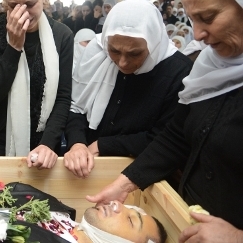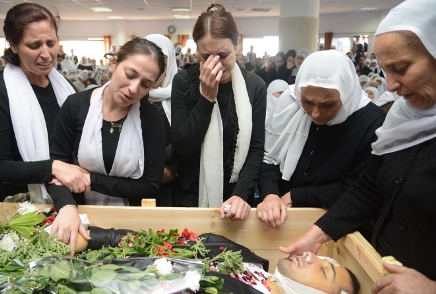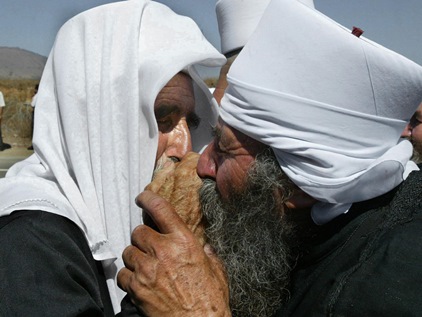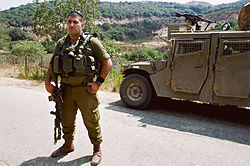
Banner

‘We’re Am Yisroel’ says Israeli Druze leader
Published
9 years agoon
By
adminANT KATZ
Ataf Farchat, chairman of the Druze Zionist Council of Israel, explains to host Ilene Prusher LISTEN TO THE RADIO INTERVIEW why so many members of the Druze community in Israel serve their country in the IDF, police, and intelligence service compared with other minority groups in Israel.
He says that since this summer’s Gaza war the Druze community has suffered negative propaganda and even attacks at the hands of certain Muslims.
Many Orthodox Jews last week attended the funeral of Zidan Saif, the Druze policeman who was mortally wounded in the process of trying to stop the terror attack at the Kehilat Bnei Torah Synagogue in Har Nof on Tuesday.
Where do the Druze fit into things?
The Druze community in Israel accounts for less than 2 per cent of the population, numbering around 122 400 of a total of about seven million. While ethnically categorised as Arab, sharing the same culture and language with the larger Arab community in the region, the Druze of Israel largely consider themselves as distinctly separate from the Palestinian Arabs, instead choosing to emulate the “Israeliness” bestowed upon them by virtue of their privileged non-Jewish status.
 RIGHT: Family gather round the coffin of Zidan Saif. Credit: Flash90.
RIGHT: Family gather round the coffin of Zidan Saif. Credit: Flash90.
Israel has often been described as a “melting pot”, absorbing the influx of Jewish migrants from Europe and North America, Ethiopia and its surrounding Arab neighbours, and combining these elements with the non-Jewish peoples which predated the Declaration of Independence in 1948.
As stated by Mordechai Nissan, “…the Druze constitute one component on the pluralistic map, enjoying liberty, demanding equality, and holding a special status among Israel’s non-Jewish population”.
Prime Minister David Ben-Gurion, modern Israel’s founding father, himself recognised the importance of this bond. There exists between the two peoples, he said, a “covenant of blood”.
Who are the Druze?
The origins of the secretive Druze faith can be traced back to 11th-century Egypt. One of its first prophets was al-Darazi, and from him came the name Druze. They are Muwahhidun, or unitarians, believers in absolute monotheism. The tenants of the faith are shrouded in mystery, revealed only to those deemed truly committed. It is known to be an offshoot of Ismailism, to which very little of its commonalities remain; all central Islamic obligations such as daily prayer and pilgrimage were eliminated; conversion to their faith is impossible; marriage to a non-Druze is forbidden. The present-day community numbers, in total, nearly one million people, settled in the mountainous regions where Lebanon, Syria and Israel meet.
The special relationship which has grown between the Druze and the Jewish State is based on the mutual history of persecution.
Islam relegated the Jews to the “tolerated” and inferior status as dhimmis https://www.sajr.co.za/images/default-source/People/single/druze-embrace.jpg” class=”sfImageWrapper”> LEFT: Two Druze men in a traditional embrace
LEFT: Two Druze men in a traditional embrace
In 1930, Itzhak Ben Tzvi, then co-director of the Joint Bureau for Arab Affairs (later Israel’s second president) published a report entitled “The Establishing of Good Relations with our Neighbours, the Druze in Eretz Israel”. In this report, Ben Tzvi laid out a “series of steps” to cultivate friendship with the Druze community. During the revolts in 1936-39, and in the early years of the Second World War, the Jewish Agency consolidated these ties. The Haganah’s intelligence service stationed officers in Haifa and in the Galilee worked with senior Druze contacts.
This did not go unnoticed by the Palestinian factions operating at the time. The Muslim Brethren in Haifa monitored the transactions of the Druze, visiting the villages to court their support in the impending war, and recruiting Druze youngsters to their ranks.
Following the Israeli Declaration of Independence on May 14 1948, and the subsequent outbreak of the Arab-Israeli War, the Druze, on the whole, continued to keep a cautionary distance. Witnessing the defeat of the ALA and the checking of Arab armies’ invasion, in the end a full alliance with the Jews seemed favourable. Similarly, the Israeli Defence Forces (IDF) made it a priority to seek out the Druze villages, offering protection and to secure their co-operation.
Relations with neighbouring Muslim villages deteriorated, blamed for treachery. While the war continued, the Druze occupied the “no-man’s land” between the IDF and the ALA lines, and villages maintained a tactic of obfuscation; covert allegiance with the IDF while outwardly appearing neutral or in favour of the Arabs.
Following the ceasefire, Israel looked to the issue of the non-Jewish population which now resided within its borders. Prime Minister Ben-Gurion recognised the importance of maintaining a strong relationship with the Druze.
Lebanon and the Golan Heights
Communal loyalty, hifz al-ikhwan, with their brothers in Lebanon and Syria has always been a difficult notion for Israel to acknowledge. In the “first order of values”, the Druze are fiercely loyal to the Druze people, yet are no less fiercely patriotic to Israel. There is no single formula to clarify the boundaries of Druze loyalty: both the state and the community legitimately demand their loyalty, and the Druze will stand with both the state and their own particular community.

RIGHT: Druze commander of the IDF Herev battalion. Druze citizens are prominent in the Israel Defence Forces, and a considerable number of Israeli Druze soldiers have fallen in Israel’s wars.
After the Six Day War in 1967 Israel annexed the Golan Heights.
6 396 Syrian Druze residents, out of a population of 130 000, chose to remain and adopt loyalty to Israel.
Looking towards the future
The entry of Druze into the public sphere and to high level appointments is a work in progress. MK Majalli Wahabi became the first non-Jew to act as Israel’s head of state when he was appointed as acting president following former President Moshe Katzav’s leave of absence in 2007. On April 22 2012, Foreign Minister Avigdor Lieberman appointed Druze Professor for Hebrew Literature Naim Araidi as Israel’s ambassador to New Zealand, the first time a member of the Druze community had been given such a political appointment.
Politically, the Druze first tended to support Labour, later branching away to Likud and Arab parties. Today, the Druze are spread across the political and ideological spectrum.




